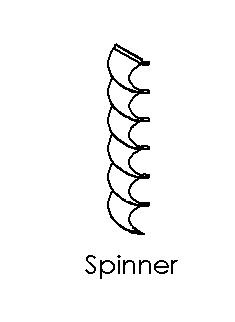Hahaha wow that is a super simple design there
Most residential hot water heaters have a flu that goes through the middle of the tank. In order to increase the amount of heat transferred trough the wall to the water a ‘spinner’ is placed in the flu. This spinner is a simple piece of twisted sheet metal. It makes the hot combustion gasses swirl. The hot gasses follow a longer, spiral shaped path and they move faster which creates turbulence. Both encourage heat transfer.

That design there would let me burn the same wood chunks as I would burn from a gasifier once it’s going.
Yes, the “pocket rocket” is the same arrangement I used in the tall propane tank to heat my pool. The cement ballasted tank rested on the pool bottom. The commercial snorkel stove has a couple of extra advantages. It has horizontal tubes passing through the under water flue section. Also it is made of aluminum for high heat transfer and no rusting.
Interesting. Was the exhaust hot? I would have put some sort of spiral shaped baffle in it so that more heat would be transferred to the water.
Rindert
In my setup, the flue and the fuel tube were both welded into the top of the propane tank which was above the water line. Adjusting a damper in the 4 inch flue pipe and covering the 4 inch fuel tube/draft offered good fire control. For my purposes, I just kept the fire as hot as possible in the tank to bring the pool temp up as fast as possible. A hot fire deep in this skinny immersed wood stove gives off a lot of heat to the surrounding water.
Just convert a gas (natural or propane) water heater to fire wood. They’re plentiful, simple and have safety pop valves already in them. I did it:
You would need a circulating pump, these are also relatively inexpensive and easily available.
Unfortunately up here in Canada natural gas is not widely available so there are very few gas water heaters.
That’s right, I remember now–Canada has a good bit of hydro. But it still does make more sense to just heat the water directly with a wood burner. Electric elements could be convenient, but I would tend to want to then capture the heat from the exhaust from the engine and do something (heat water) with it. You need power at your cabin anyway huh?
Yeah it’s funny you say that about Hydro. I am going to have a 4-foot overshot water wheel turning a DC generator for power at my cabin.
I really like that submerged rocket stove pipe setup. I think that is probably the most efficient use of heat. And if there’s any smoke from the stove at all it’ll help keep the bugs away. LOL
Actually the rocket stove will burn clean releasing CO2 and probably draw in the bugs. That is his the bug magnets I think they where called that burn propane work biting insects use our breath to find us and any CO2 supply draws them in. Smoke only drive them off because of the other toxic byproducts of a poor quality burn.
I’m guessing the trace amounts of combustion byproducts would be enough to deter the bugs, it would be very hard to achieve perfect combustion. Also the heat plume should take the gases skyward.
That’s my theory anyways.
Well once he builds it we will know.
Hi All,
Some of you who have made rocket stoves might comment on an idea I’ve been kicking around for a while now.
A natural gas hot water heater should be able to use the same basic principals that make rocket stoves so efficient. ‘B-vent’ water heaters are very reliable. They collect sludge in the bottom and need to be emptied and cleaned out once a year. They are essentially what is called a ‘fire tube boiler’. Whereas most demand water heaters are ‘water tube’ boilers, and are sensitive to sludge buildup and clogging, though they are more efficient.
So, it seems to me that a rocket stove integrated into a ‘b-vent’ water heater should allow sludge to collect in the ‘mud ring’ area, just as always did, and create the conditions necessary for the high efficiency heat transfer that are found in rocket stove systems.
Rindert
Here I started reading this thread, I must have missed from a few years ago. All I could think is it would be a good way to use waste heat from the charcoal making process. ![]()
It would be a great way. Just replace the gas burner with a TLUD. Oh, and give a thought to condensation and where it would go.
It might get too hot, and you will end up like a lobster.
One nice thing about TLUD’s, you can fill the fuel container with as much or as little fuel as you need. If you remove the hot charcoal, then you’re done. If you don’t, the heating rate drops quite a bit when it switches to char burning. Unless you’re trying to heat water to near boiling, the unwanted extra temperature is probably not going to be a big problem.
Most every DIY water heater thread ends up in the same place. A weary world needs folks to try their ideas and see what happens. Here, (Again…) is our own Dan of Dansw0rkshop Youtube channel and DOW member showing his proven, used daily, domestic hot water system using many ideas proposed, yet again, here on this thread.
Link to Dan’s YouTube channel…
Not clearly shown, there is a standard gas-fired water heater setting on top of the round “woodstove”. Everything below the water tank, like burner, skirt, and legs, has been trimmed-off.
Yee Haa! ![]() …
…




